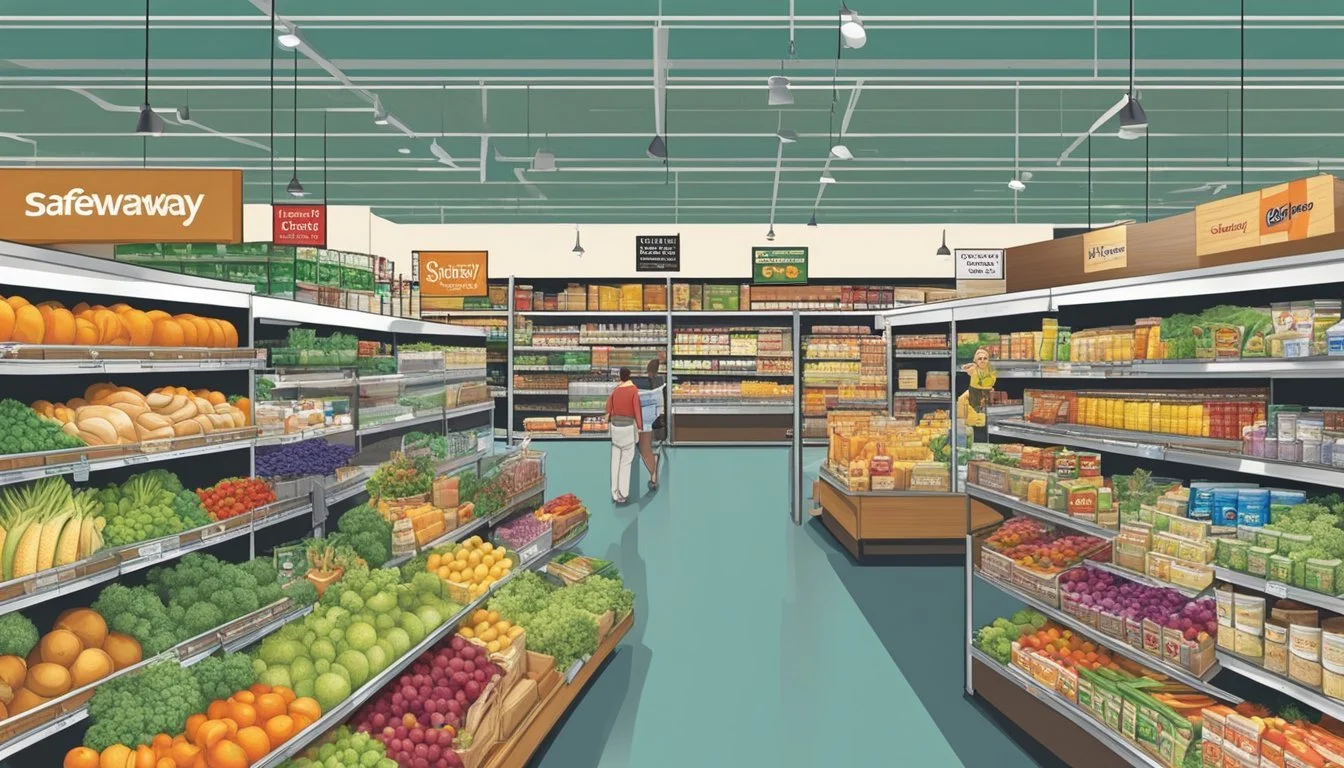Safeway vs H-E-B
Comparison Determining the Superior Grocery Shopping Experience
Choosing the right grocery store is crucial for consumers who value both quality and affordability in their food shopping experience. Safeway and H-E-B are two supermarket chains that often come up in discussions about the best places to purchase groceries. Safeway, with locations primarily on the West Coast, has been praised for its bakery, especially the cakes that have garnered positive reviews for quality and inexpensiveness. On the other hand, H-E-B, a Texas-based chain, offers an impressive array of food items including a variety of birthday cakes and private-label products that cater to local tastes.
Each grocery store boasts distinctive features that appeal to different types of consumers. Safeway has established itself as a reliable supermarket that satisfies the needs of its diverse customer base with its high-quality offerings, while H-E-B has earned a reputation for not only the range of products available but also for the unique grocery shopping experience it provides. Both stores have secured their places in the American grocery landscape, with shoppers often recommending one over the other based on personal preferences and regional availability.
When comparing Safeway and H-E-B, it is important for shoppers to consider a number of factors, including product variety, grocery pricing, store ambiance, and customer satisfaction. The comparison is not just about who takes the lead in a head-to-head challenge, but also about understanding the distinct strengths of each chain that resonate with their respective customer bases. As households continue to evaluate their grocery shopping choices, the Safeway versus H-E-B debate remains a topic of interest for many seeking the best overall value.
Company Profiles
This section provides a detailed look into the historical development and market progress of two major grocery store chains: H-E-B and Safeway. Each company has shaped the grocery landscape through its distinctive history and market evolution.
History of H-E-B
H-E-B began as a small family-owned store in Kerrville, Texas, in 1905. Florence Butt founded the store with a $60 investment which has now transformed into over 340 stores across Texas and Mexico. H-E-B has maintained a significant presence in the Texas grocery market, characterised by deep community involvement and innovation in its retail practices.
Safeway's Market Evolution
Safeway, established in 1915, has undergone various changes to maintain its relevance in the grocery industry. The company has been noted for its adaptability over the decades, expanding and contracting its chain as market demands and competition dictate. Safeway emerged as a grocery innovator, being one of the first to introduce produce quality guarantees and nutritional labeling.
Product Selection and Quality
When comparing Safeway and H-E-B, it's crucial to consider the range and caliber of products each supermarket offers, particularly in key departments like produce, bakery, and meat.
Produce and Organic Selection
Safeway prides itself on a robust organic section that caters to health-conscious consumers, carrying a wide assortment of fresh fruits and vegetables, including specialty organic items. H-E-B, on the other hand, offers a competitive produce department known for its fresh, quality selections, with a focus on locally sourced items that bolster its connection to Texas communities.
Bakery and Freshness
At H-E-B, shoppers routinely find a variety of store-brand snacks as well as freshly made guacamole and pico de gallo. The bakery excels with its H-E-B-favorite fresh tortillas. Safeway counters with an expansive bakery, known for an array of freshly baked bread, pastries, and custom cakes that emphasize freshness and flavor, striving to hit the mark on both everyday staples and special occasion treats.
Meat and Seafood Variety
For meat and seafood, H-E-B has a reputation for quality and variety, providing customers with a wide selection from standard cuts to gourmet options. Their commitment to quality extends to their partnerships with trusted suppliers. Safeway offers a diverse selection as well, with a range of options that appeal to the casual shopper and the culinary enthusiast alike, ensuring quality and freshness are consistent across their stores.
Pricing and Value
When comparing Safeway and H-E-B, understanding their pricing strategies and the value they offer is essential. Both stores have distinct approaches that cater to different consumer needs, with Safeway known for a mix of quality and savings, and H-E-B distinguishing itself with competitive pricing and regional product offerings.
Comparison of Everyday Prices
Everyday prices are a critical factor for shoppers, and both Safeway and H-E-B offer competitive pricing. However, H-E-B often leads with lower prices on many staple items compared to Safeway. For example, consumers may find:
Milk: H-E-B offers it at a price point that is typically $0.20 less per gallon than Safeway.
Eggs: Customers save about $0.15 per dozen when shopping at H-E-B.
Discounts and Coupons
Both grocery stores provide savings through discounts and coupons. Safeway is known for its Just for U digital coupon program, which offers personalized deals and discounts, whereas H-E-B extends savings through in-store coupons, weekly ads, and digital coupons via its H-E-B app.
Weekly Ads: Safeway and H-E-B advertise similar percentage-off deals weekly.
Digital Coupons: Safeway's Just for U offers exclusive deals; H-E-B's digital coupons are easily accessible through their app.
Premium Brands and Cost Effectiveness
Regarding premium brands, Safeway carries exclusive lines such as O Organics and Signature Select, offering a balance between cost and quality. In contrast, H-E-B boasts its own branded products that often undercut competitors' prices while maintaining quality.
Whole Foods: Safeway's organic line competes well with Whole Foods, offering lower prices for similar quality.
Cost Effectiveness: H-E-B's branded items frequently rival the cost-effectiveness of shopping at other value leaders like Walmart and Costco.
In summary, both Safeway and H-E-B have their merits in terms of pricing and value, with various options to save money through discounts, coupons, and store brands.
Store Experience
When comparing Safeway and H-E-B, shoppers' in-store experience largely hinges on the aisles layout and cleanliness, the customer service, and the range of in-store amenities both retailers provide.
Aisles Layout and Cleanliness
In H-E-B stores, customers often find wide aisles and high standards of cleanliness which aid in a stress-free shopping experience. Safeway similarly prioritizes clean aisles and usually employs a logical layout that allows shoppers to navigate easily through different segments. Both retailers recognize the importance of store cleanliness, including shelving and floors, to enhance the overall shopping environment.
Customer Service and Support
Shoppers at H-E-B generally report efficient and friendly customer service, with staff readily available to assist with queries and concerns. Safeway also prides itself on customer service, typically offering a satisfactory support experience. Both stores seek to provide assistance briskly, understanding that customer service is crucial for a pleasant shopping experience.
In-Store Amenities and Special Features
H-E-B stands out for its in-store amenities, including a robust beauty department and convenience services like curbside pickup. Safeway counters with its own range of amenities, focusing on the convenience of on-the-go meal solutions and a variety of organic options. Each store's amenities are tailored to the needs of their customer base, aiming to provide a unique and beneficial shopping experience.
Brand Diversification
Brand diversification is a strategic approach that grocery stores use to enhance customer experience and promote customer loyalty. H-E-B and Safeway employ this strategy through exclusive and partnership brands, offering a variety of products ranging from organic to gluten-free options.
H-E-B's Exclusive Brands
H-E-B has developed a strong private label brand presence with exclusive lines such as Central Market and Hill Country Fare. Central Market caters to the premium market with a focus on unique and high-quality products, including an extensive selection of organic items. Hill Country Fare, on the other hand, aims at cost-conscious consumers, providing a broad range of products at affordable prices. H-E-B's commitment to brand diversification is evident in their ability to offer something for everyone, enhancing their competitive edge in the retail sector.
Safeway's Partnership Brands
Safeway has taken a different approach to brand diversification by collaborating with various brands to augment their product offerings. They partner with a myriad of brands to offer customers a diverse selection. This includes a variety of organic and gluten-free products to meet the increasing demand for health-conscious and dietary-specific foods. Safeway's brand partnerships enable them to provide a plethora of options to cater to a wide customer base, thereby fostering loyalty through variety and choice.
Specialty Items and Dietary Needs
When comparing Safeway and H-E-B, one must consider the range and quality of their specialty items, particularly for those with dietary restrictions or gourmet tastes. This comparison touches upon how both grocery stores cater to the growing demand for gluten-free options and allergy-sensitive products as well as their selection of gourmet and international offerings.
Gluten-Free and Allergy-Sensitive Products
Safeway offers a respectable assortment of gluten-free and allergy-sensitive products. One can find gluten-free bread, pasta, and baking supplies, often under their own brand label as well as reputable brands like Udi's. For those with other dietary restrictions, a variety of dairy-free and nut-free options are typically available.
H-E-B, while serving a more localized clientele, has responded to dietary trends with a remarkable selection of gluten-free items. This chain often carries products that cater to a Texan palate but also includes goods such as gluten-free flours and ready-to-eat meals from brands like Schar and Amy's that are well-suited for those with sensitivities.
Gourmet Food and International Cuisine
Safeway, with its widespread presence, stocks a vast range of international cuisine ingredients, rivaling stores like Trader Joe's and Whole Foods in some locations. Safeway's gourmet section includes artisan cheeses, imported chocolates, and a curated selection of international wines and beer, fulfilling the needs of the adventurous home chef.
H-E-B excels in offering a localized gourmet experience, akin to smaller yet specialty-focused chains like Central Market. They provide an enticing array of gourmet foods, including specialty meats, in-house roasted coffees, and an extensive selection of Texan and Mexican cuisines. Their commitment is evident in their fresh produce section, which features seasonal and hard-to-find ingredients that reflect the local taste above mainstream offerings.
Location and Accessibility
When evaluating location and accessibility, it is important to consider the geographical span of both Safeway and H-E-B, as well as their ability to adapt to the digital marketplace through online shopping and delivery options.
Geographical Coverage and Convenience
Safeway, while once a dominant player across various regions, currently operates mainly in the western and central parts of the United States, with a significant number of stores situated in California. H-E-B, on the other hand, has established a strong presence in Texas, with over 400 stores strategically placed throughout the state, including major cities like Austin. This makes H-E-B highly accessible to Texas residents. Both chains face competition from national giants such as Walmart and Target, which have stores spread across the country.
Safeway Stores: Primarily in the Western and Central U.S.
H-E-B Stores: Over 400 locations in Texas.
Online Shopping and Delivery Services
The digital transformation of the grocery industry has made online shopping and delivery services crucial. H-E-B offers online shopping through its website and app, along with delivery and curbside pickup options. They directly compete with delivery services like Amazon, which has a significant footprint in the online retail space, including groceries. Safeway responds to this trend by providing online grocery shopping and home delivery options. Both companies aim for convenience but strive to maintain their local appeal in the face of growing pressure from omnipresent e-commerce retailers like Amazon and Walmart, which also offer extensive grocery delivery services.
Online Shopping: Web and mobile platforms available from both Safeway and H-E-B.
Delivery and Pickup Services: Delivery and curbside services offered to enhance convenience.
Community Engagement and Sustainability
When comparing Safeway and H-E-B, two important factors come into play: how they support local communities and their commitment to sustainability. Both of these aspects are increasingly significant to consumers who value corporate responsibility and environmental stewardship.
Local Community Support
Safeway prides itself on its relationship with local families and communities. Through various initiatives, including fundraising programs and partnerships with local food banks, Safeway works to make a positive impact. The company often tailors its support to the specific needs of the communities it serves, whether that involves sponsoring local sports teams or donating to schools.
H-E-B, on the other hand, has a strong presence in Texas and is known for its H-E-B School of Retail Leadership which develops future community leaders and business professionals. The company is also involved in disaster relief efforts and contributes to social causes, reflecting a tight-knit relationship with the communities in which it operates.
Environmental Responsibility and Green Initiatives
Safeway has taken steps towards environmental responsibility by implementing measures such as energy-efficient lighting and refrigeration in its stores. It promotes sustainable and organic product lines, giving consumers eco-friendly shopping options. Additionally, Safeway's commitment to reducing waste can be seen in its recycling programs and use of compostable materials.
H-E-B demonstrates its commitment to sustainability particularly through its responsibly sourced seafood as noted in their policy collaborations with the Environmental Defense Fund. The company's efforts to sustain seafood populations are transparent on its website, including informative videos and a detailed sustainability chart. H-E-B's initiative reflects a broader dedication to environmental sustainability and responsible sourcing. However, they have received criticism regarding their policies on single-use plastics, suggesting there is room for improvement in their green initiatives.
Consumer Perceptions and Brand Loyalty
In the grocery retail space, consumer perceptions and brand loyalty are pivotal factors in a store's success. H-E-B and Safeway have crafted distinct brand identities, focusing on customer experience and loyalty programs that resonate with their respective customer bases.
Customer Satisfaction Surveys
H-E-B consistently performs well in customer satisfaction surveys, indicating a strong alignment with consumer expectations. Research from dunnhumby revealed H-E-B outperforming other grocery retailers, including Trader Joe’s, in America. In similar studies, such as those conducted by Market Force, H-E-B, along with other brands, was recognized for receiving a significant proportion of consumer spending, which is a testament to its strong customer satisfaction levels.
Safeway, with its robust customer loyalty programs, shows dedication to providing value through its Just4U app. Safeway's customer service and loyalty initiatives have been pivotal in its success in fostering repeat business, often implementing a two-part loyalty program that has strengthened its customer satisfaction scores.
Brand Advocacy and Repeat Business
H-E-B's toppling of Trader Joe's from the top spot in the grocery sector speaks volumes about the strength of its brand loyalty and advocacy. The San Antonio-based grocer has become a favorite among consumers, fostering a high degree of repeat business through a combination of competitive pricing, quality products, and localized marketing efforts.
In contrast, Safeway's approach hinges heavily on their loyalty program's integration with technology, such as the Just4U app, to tailor customer experiences and encourage repeat visits. Their investment in personalization has been a strategic move in boosting brand advocacy and cementing consumer loyalty.
Conclusion
When comparing Safeway and H-E-B, consumers are looking at several factors: product range, quality, pricing, and overall shopping experience. H-E-B has a reputation for offering a wide array of private-label products that cater to a variety of tastes and needs. They have been recognized for not just the breadth of their offerings, but also the quality, especially in their private-label selection.
Safeway, on the other hand, has a longstanding history of providing grocery services. They have established themselves as a reliable store that has maintained a connection with communities around their locations. However, when evaluating store transformations and adapting to consumer needs, H-E-B's commitment to innovation gives it an edge.
In terms of pricing, customer surveys have shown stores like Walmart and Food Lion to be more affordable compared to others, but this does not take away from the competitive prices that Safeway and H-E-B offer on many items.
The "best" grocery store can often hinge on personal preferences and priorities. Some customers may value the unique products and regional flair that H-E-B provides, while others might prioritize the familiarity and nationwide presence of Safeway.
In conclusion, the decision on which store is the definitive "best" is subjective to consumer choice. H-E-B has won acclaim for its quality and innovative approach, while Safeway remains a staple with a trusted reputation. Shoppers' individual preferences in various factors—convenience, pricing, quality, and product range—will ultimately guide their choice between these two grocery store leaders.








